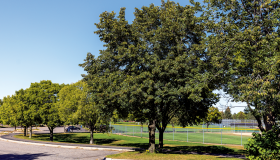Natural Resources
Parks and Recreation Links
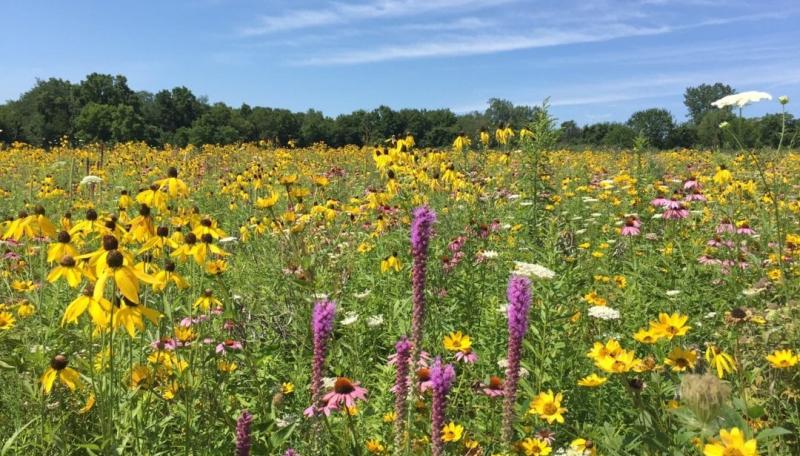
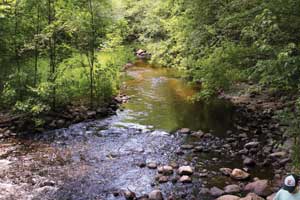
Bloomington's extensive park system includes significant natural areas. In the past, natural areas required little maintenance. Today we understand the need to actively maintain them in order to retain and improve their ecological integrity. Many external forces are at work degrading natural areas, including:
- Invasive species
- Over browsing
- Heavy human use
- Climate change.
If left unmanaged, the natural areas will continue to lose ecological function and biodiversity. So as part of the Park System Master Plan, a study was initiated in partnership with Barr Engineering to help guide the investment of financial resources and staff capacity, prioritizing the ecological communities’ management in Bloomington's parks, excluding those within the Minnesota River valley, which have already been planned. This process ranks the parks for management priority and presents strategies for the highest ranked parks.
Learn more:
Natural Resources Prioritization and Management Strategies Plan.
Minnesota River Valley Natural and Cultural System Plan (2018)
Grant Funded Projects
The City of Bloomington natural resources applies for a variety of grant funding from state, county and other sources to help fund large scale restoration projects throughout the city. Partnerships with other agencies also help fund this important work.
These projects are typically on a scale that requires more resources and capacity than is efficient for Natural Resources staff to accomplish independently. See below for a list of current grant-funded projects.
Central Park Woodland Restoration
The City is partnering with Hennepin County to perform woodland, savanna, and prairie restoration on 13 acres of land located in Central Park northwest of the intersection of W 106th St and Humboldt Ave S. The work began in November 2023 and is expected to be completed in fall 2025.
Primary Project Goals and Objectives
- Reduce cover and occurrences of woody and herbaceous invasive plant species.
- Increase abundance, occurrence, and diversity of native dry/mesic oak savanna, mesic forest, and prairie species.
- Improved oak savanna, mesic forest, and prairie habitat structure.
- Improve habitat structure and suitability for rare features like kitten-tails and monarchs.
This project is broken up into three sections based on the habitat being restored. Oak woodland covers a majority of the eastern portion of the project area, while mesic forest is to the north and savanna on the western ridge.
Savanna restorations often require removal of mature trees. This is necessary for the overall benefit of the restoration area. For this project, the savanna habitat being restored is the ridge top that was historically more open than the area surrounding it, as evidenced by historical aerial photos and observation of different age groups of trees growing in adjacent areas. Populations of state threatened kitten-tails (bessya bullii) currently growing on the ridge are declining due to lack of sunlight. Restoring kitten-tail habitat was a major reason for choosing this area for restoration.
What is the need?
Natural landscapes are diverse and cannot simply be summed up by the word "woodland". There is more to wooded areas than trees. They are dynamic systems that require a wide variety of flora and fauna to remain resilient, which is what restoration work aims to assist with. This project area has been invaded with species that are detrimental to the health of the surrounding area, causing:
Increased erosion
Loss of biodiversity
Decreased pollinator habitat.
This project area includes a high number of mature red cedar trees (Juniperus virginiana). Though native to the area, they can become locally invasive in prairie and savanna habitats. Natural disturbances (fire, grazing) that once kept cedar populations in check have been removed, allowing cedars to overtake the area.
Cedars create a canopy that is so dense that light is unable to reach the ground level vegetation. With no roots in the ground to stabilize the soil, erosion becomes a problem, especially on steep slopes like those in the project area. Part of this restoration is to restore or mimic natural disturbances to return the savanna conditions that existed in the past.
What is being done with the trees?
The wood from the removed cedars is being repurposed to reduce waste.
Some of the cedar trees are being utilized as erosion logs, where they will be laid out across the slope to slow soil loss.
Cedar boughs are being used in this same manner.
In winter 2024, staff collaborated with staff from the City of Minnetonka to utilized its wood mill and saw the cedar logs into usable lumber. The boards from this collaboration will be used as material for park improvements throughout the City.
In spring 2024 a review will be conducted to determine if further need for erosion control exists. If so, temporary cover crop may be needed.
Who is doing the work?
Hennepin County is the lead agency on this project. The City of Bloomington provided Hennepin County with a right of entry to conduct work in the project area. Hennepin County hired Resource Environmental Solutions, LLC (RES) to perform the work. RES is the nation’s largest ecological restoration company. Its mission is to restore land and water with ecological integrity and innovation and support the rehabilitation and stewardship of nature’s resources alongside responsible human progress. Hennepin County is monitoring wildlife populations as part of this project.
Summary
- Cedars are being removed to allow establishment of ground level vegetation and restore the area to its historical dry/mesic savanna habitat.
- This project will enhance habitat for state threatened kitten-tails
- This restoration aims to help mitigate the obvious erosion issues in the project area.
- Hennepin county is monitoring wildlife populations as part of the project.
- The entire project is being conducted in accordance with the Natural Resources Prioritization and Management Strategies for Bloomington Parks plan developed in July 2022.
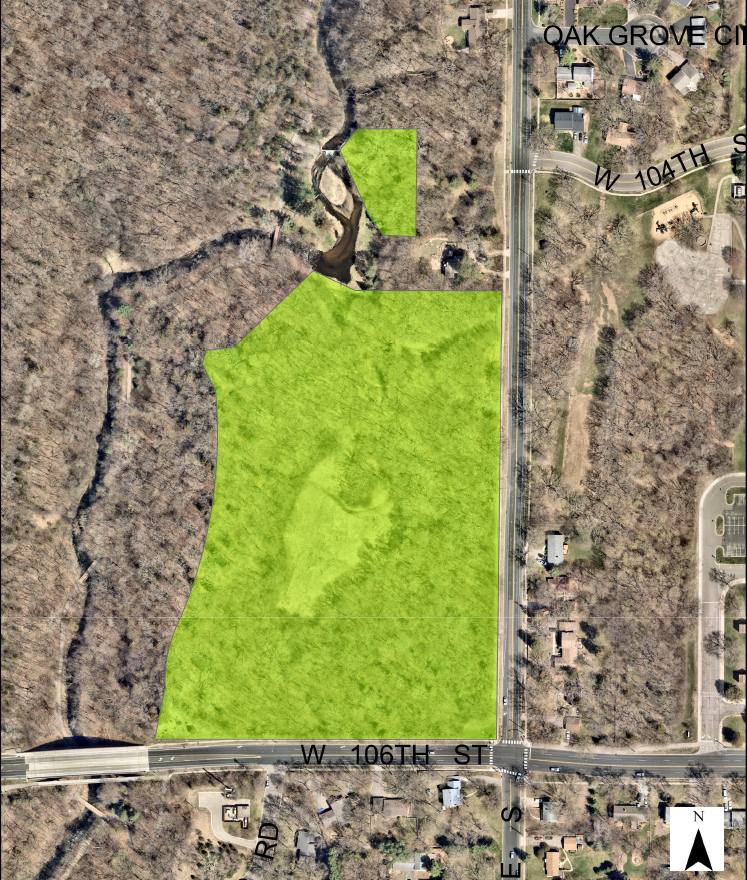
Marsh Lake GRG Partnership - West 98th Street and France Avenue South
The City is partnering with Great River Greening to restore 13 acres of land at Marsh Lake Park beginning in 2025. This project seeks to restore oak savanna, mesic and wet prairie habitats. The project is being funded by Lessards Sams Outdoor Heritage Council as part of a package put together by Great River Greening for ecological restoration work in areas that impact rivers in the metro.
Initial planning for this project began in winter 2023. Official approval to begin work occurred in July 2025. The project is currently in the process of finalizing details and hiring a contractor. Work is expected to start in fall 2025.
Pond Dakota Oak Woodland Restoration
The City has received a Conservation Legacy Partners grant through the MN DNR to perform a 20-acre oak woodland restoration project adjacent to Pond Dakota Mission Park and the historic Gideon and Agnes Pond House at 401 East 104th Street.
This significant project helps continue the work outlined in the 2018 Minnesota River Valley Strategic Plan and will tie together two previously restored woodlands on the east (Parker’s Picnic Grounds) and west (Hopkins Farm Park) boundaries, creating a 60-acre corridor of oak woodland and oak savanna.
In addition, the initiative will focus on several other important tasks including:
- Preservation of ancient Bur oak trees
- Providing bluff top views of the Minnesota River
- Increasing native plant diversity
- Protecting cultural heritage areas.
This work will occur between fall 2023 and summer 2026.
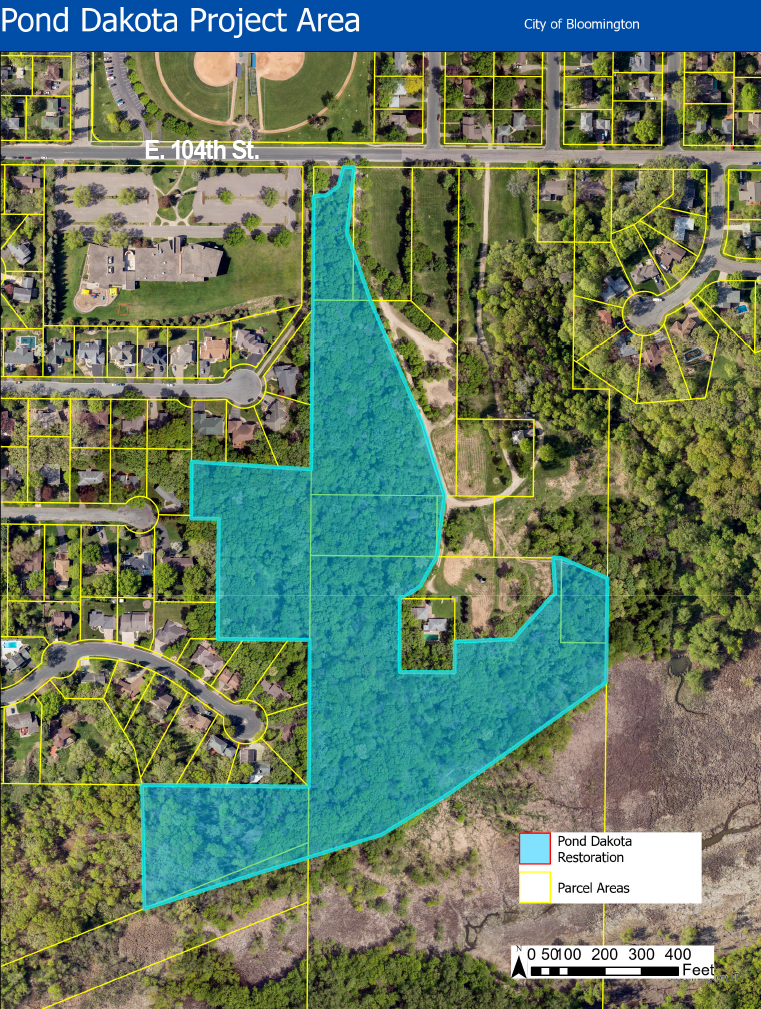
Tarnhill Oak Habitat Restoration - 9650 Little Road
The City has received grant funding from the Conservation Partners Legacy (CPL) grant from the Minnesota Department of Natural Resources and Lessards Sams Outdoor Heritage Council to perform eight acres of oak habitat restoration at Tarnhill Park, 9650 Little Road. The grant was awarded in February 2025 with work anticipated to begin in fall 2025 and conclude in summer 2028.
This project will improve habitat for native oak tree species and wildlife by removing invasive brush and pioneering trees, enhancing ground layer vegetation and increasing oak regeneration and overall habitat.
The City currently manages 11.5 acres of native prairie in the areas adjacent to the project, which is listed as a priority in the City’s Natural Resources Prioritization Plan.
Questions? Contact Dave Hanson, Assistant Director of Parks and Natural Resources at dhanson@bloomingtonmn.gov.
Project Updates
November 11, 2025: Brush and tree removal work began on Tuesday, November 11 with contractors using heavy equipment to stage piles. City staff will haul piles as time and schedules permit. Given the amount of material being removed, piles will remain in the area for a period of time until they can be hauled away.
Project Work Area
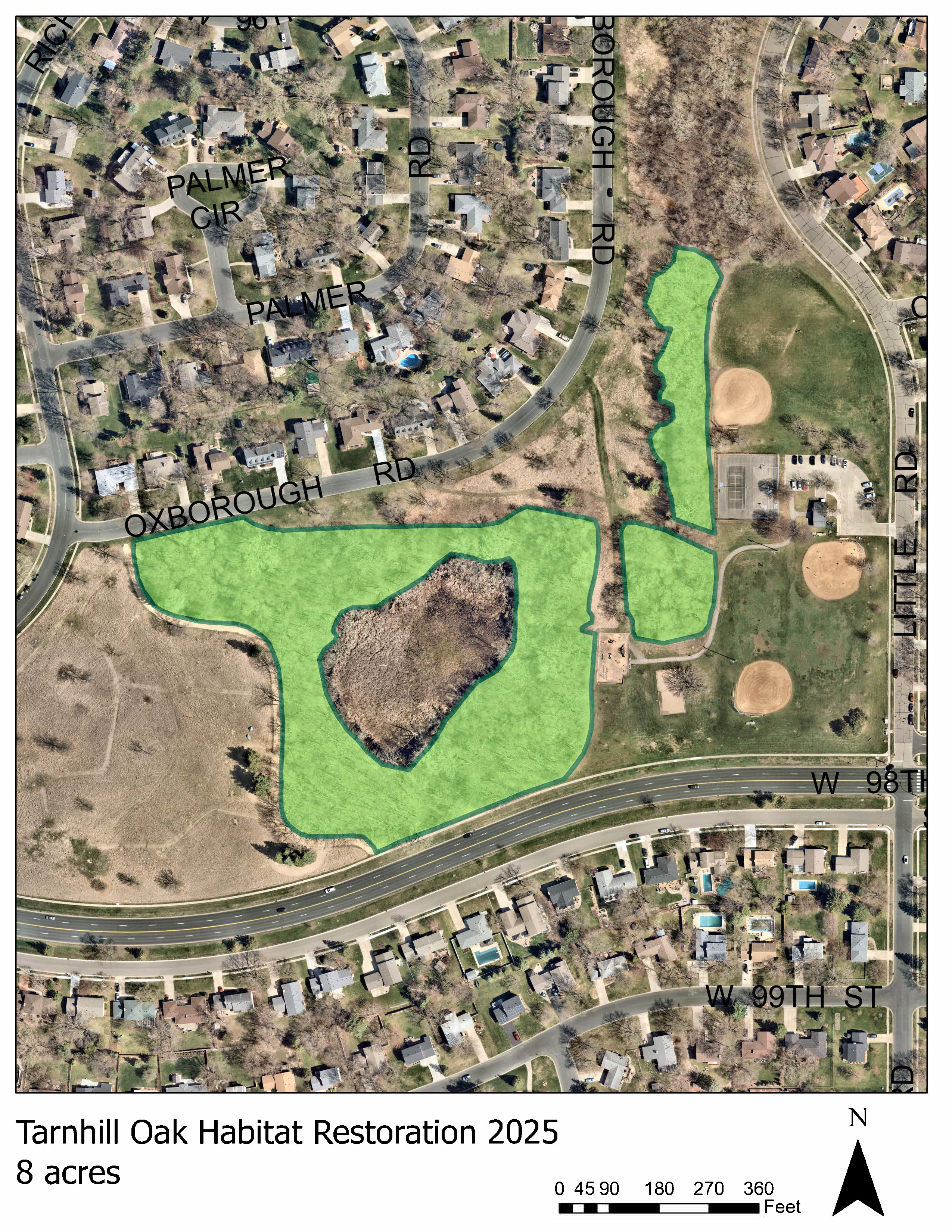
Staff-Led Projects
The City of Bloomington natural resources staff directly manages multiple restoration and maintenance projects throughout the city. Projects are continually added to the active list below, and primarily include prairie, savanna and woodland restoration and management. See below for a list of current projects.
July 2025: Site preparation is underway for restoration work at the historic Pond House, Parker’s Picnic Grounds, Columbus Playlot, Northcrest Park, and Marsh Lake Park. These sites will receive 1-2 additional visits for site prep with seeding planned to occur in fall 2025. Refer to the individual site drop-downs below for details.
For information on the restoration process, reference the restoration step-by-step below.
Columbus Playlot - 10030 Columbus Avenue South
One acre of park property formerly managed as a reduced-frequency mowing area is being restored beginning in 2025. Existing trees within the work area will remain with the exception of trees that are dead or declining. This project is part of the Bloomington Bluegrass to Bluestem initiative, whereby the City has been converting low-use turf areas into more sustainable native vegetation with the goal of:
- Reducing maintenance improvements over time.
- Creating better habitat for pollinators.
- Improving park aesthetics.
- Creating a properly established and diverse natural area
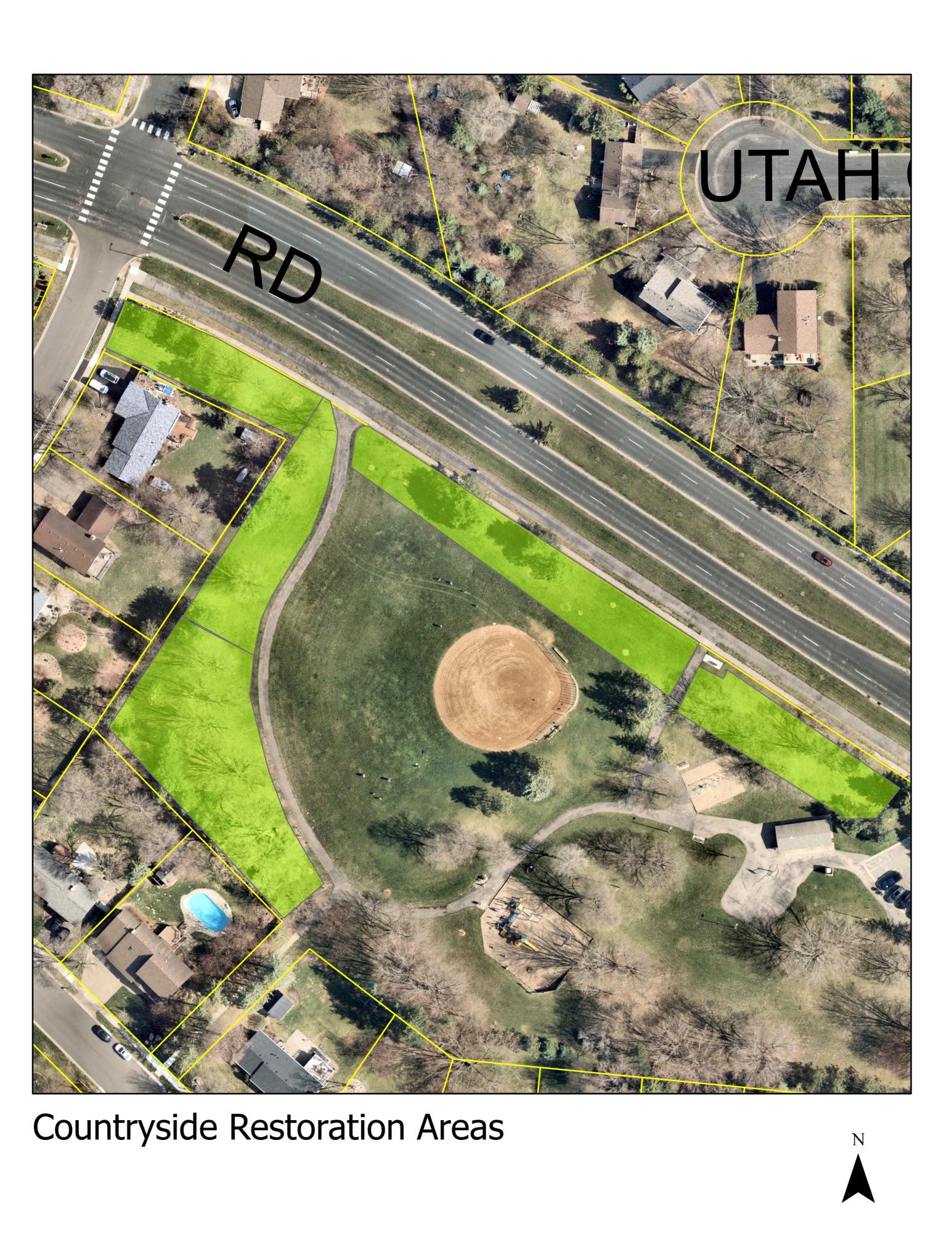
During fall 2024 the Park Maintenance Division of the City of Bloomington Parks and Recreation Department conducted natural area restoration work at Countryside Park, 10240 Bloomington Ferry Road.
The goal of this multi-year restoration was to turn low-use turf areas into more sustainable native vegetation to:
- Reduce maintenance improvements over time.
- Create better habitat for pollinators.
- Improve park aesthetics.
- Create a properly established and diverse natural area.
The site was seeded in fall 2024. Following seeding:
- After seeding, the site will green up as cover crop establishes and seedlings begin to germinate.
- An influx of annual and biennial weeds is expected due to soil disturbance from planting.
- During the first few years of establishment, it is normal for crews to mow the seeding area (see video) multiple times throughout the season. This is intended to give the slower growing seedlings more access to resources, increase species diversity and manage the pioneering weeds.
- Crews will be spot treating weeds as needed throughout the establishment period.
City crews will periodically spot treat weeds. Weekly mowing maintenance will still occur along property lines and impermeable surfaces to maintain a clean edge.
Questions? Contact Wade Yunker, Natural Resources Specialist, at wyunker@bloomingtonmn.gov.
Fenlason Park - 7901 1st Avenue South
Fenlason Park is undergoing a half-acre prairie restoration that began in August 2023. The goal of this project is to restore low-use turf areas and reduced-frequency mowing areas into more sustainable native vegetation that will improve water quality, reduce chemical usage, reduce maintenance inputs, provide pollinator and wildlife habitat, and improve park aesthetics.
Initial site preparation took place in fall 2023 but planting was delayed due to drought conditions. Ultimately, Fenlason Park was seeded in early July 2024 with a mix designed to attract pollinators and provide optimal pollinator habitat. This flower-heavy seed mix will benefit pollinators feeding on nectar, but the grass component of the mixture also provides habitat for other beneficial insects.
What happens next?
- After seeding, the site will green up as cover crop establishes and seedlings begin to germinate.
- An influx of annual and biennial weeds is expected due to soil disturbance from planting.
- During the first few years of establishment it is normal for crews to mow the seeding area (see video) multiple times throughout the season. This is intended to give the slower growing seedlings more access to resources, increase species diversity, and manage the pioneering weeds.
- Crews will be spot treating weeds as needed throughout the establishment period.
The process of restoring native areas generally takes three years until desirable establishment of vegetation is obtained. During the establishment years the site will look less than desirable. Patience is key. Please refer to the Restoration Plan: Step-by-Step on this page for more information on the process.
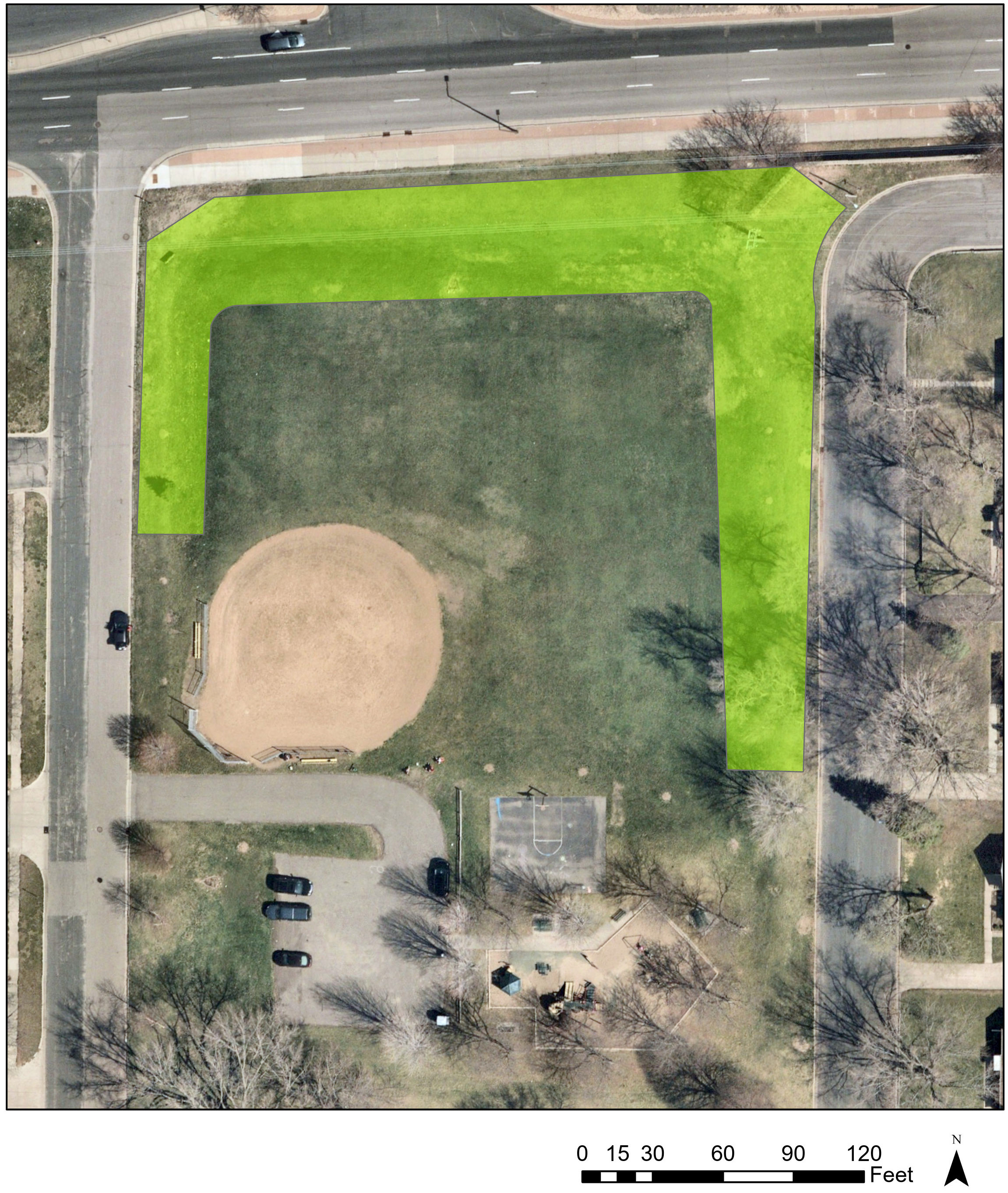
Marsh Lake Park East - near Hillcrest Elementary School
In summer 2025, the Park Maintenance natural resources team initiated a natural area restoration project on 2.5 acres of City-owned and maintained property in Marsh Lake Park East, immediately south of Hillcrest Elementary School and north of the Southbrook neighborhood subdivision.
The purpose of this project is to remove buckthorn and other invasive species that are encroaching on mature oak trees, opening the area to allow growth of native vegetation. Invasive species removal will help increase light to the ground layer while providing room for the massive oak trees to grow and flourish. This project is adjacent to Nine Mile Creek and will improve the buffer quality around the creek.
Restoration Process and Steps
- Manually/mechanically remove invasive buckthorn, honeysuckle, ash, and white mulberry.
- Following invasive species removal, the newly cleared area will receive overseeding in the winter with an oak savanna-compatible seed mix.
- Follow-up buckthorn treatment in subsequent years.
This project area is listed as a top priority for restoration in the Natural Resources Prioritization Plan. The process of restoring native areas generally takes three years until desirable establishment of vegetation is obtained. During the establishment years the site will look less than desirable. Patience is key. Please refer to the Restoration Plan: Step-by-Step on this page for more information on the process.
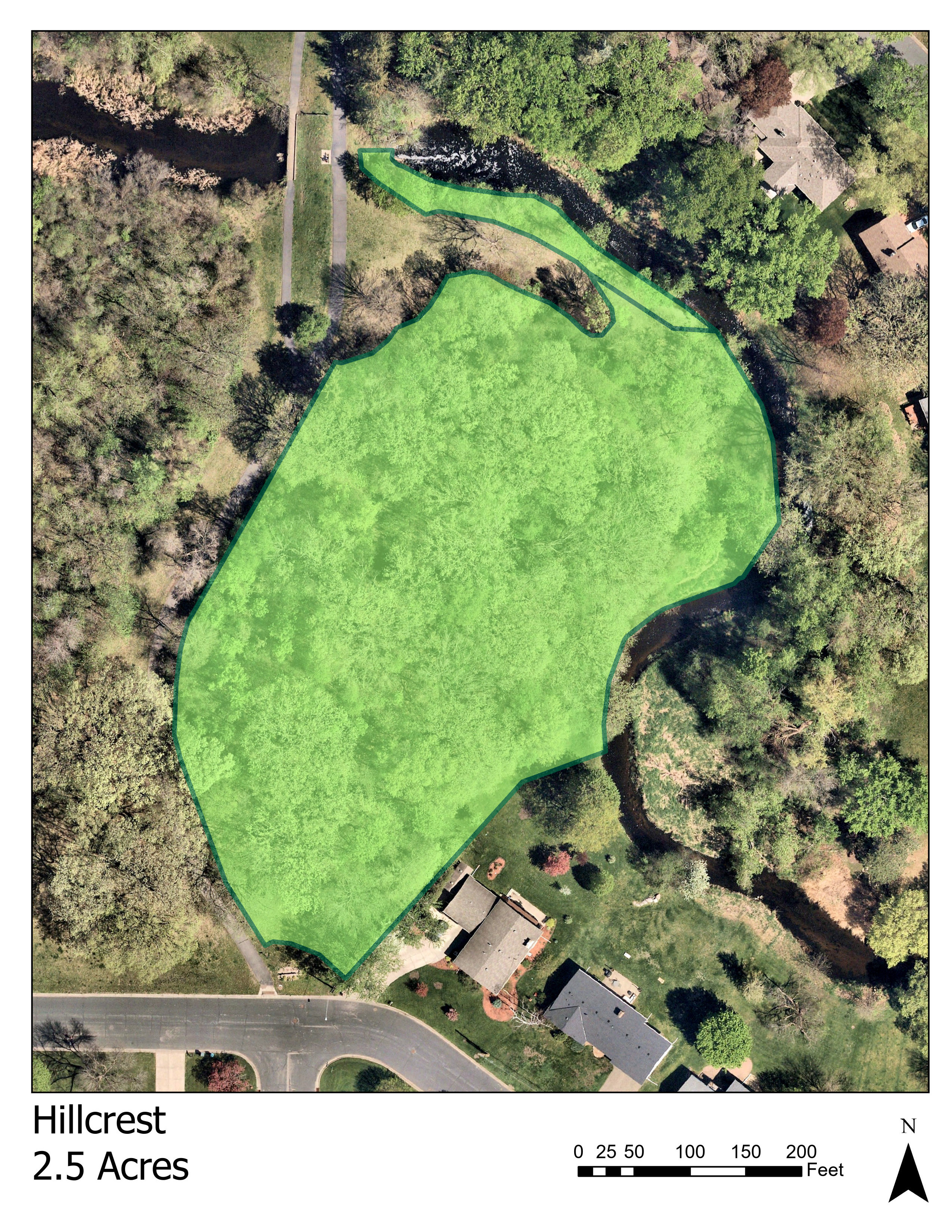
Nord Myr Park: Phase 2 - 8601 Normandale Blvd. S.
During the winter months in early 2025, Park Maintenance staff are performing natural area restoration activities at Nord Myr Park. The work focuses on removal of buckthorn around the marsh edge, thinning out stands of box elder and ash trees, and preserving larger native trees and oaks (see map below).
Following woody species removal, the area will be seeded with a native seed mix to:
- Promote diverse ground layer vegetation establishment.
- Introduce native vegetation to out-compete invasive species and volunteer trees.
- Increase suitable habitat structure for the many birds, pollinators, and mammals that frequent the site.
In addition to seeding, native tree and shrub species will also be planted in select locations.
This work expands on restoration efforts conducted in 2020 during which staff performed three acres of buckthorn and volunteer tree removal. The areas that contained dense buckthorn stands were seeded following initial removal and that action has successfully suppressed buckthorn with minimal required staff intervention and management.
This project continues improvement for Bloomington’s valuable natural resources. Nord Myr Park is listed as a top priority for restoration work as recognized in the Natural Resources Prioritization Plan.
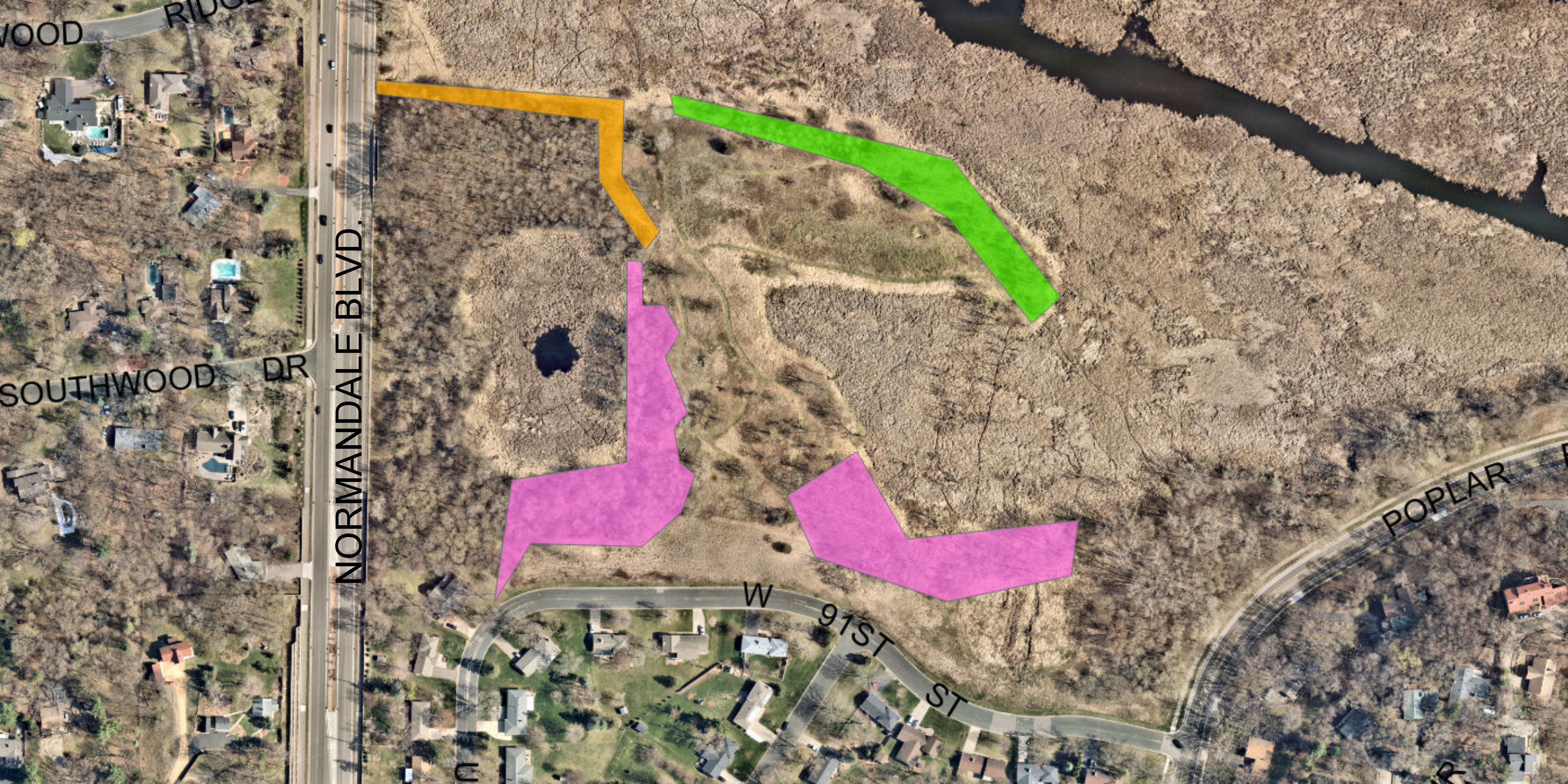
Northcrest Park - 3500 West 81st Street
A half-acre portion of Northcrest Park is being restored to native vegetation beginning in 2025. The area being restored was previously an unmaintained portion of the park. Since 2024, City forestry staff have been working to clear trees and brush while maintaining quality trees that exist on site. The City currently manages three acres of high-quality prairie on the north side of the Northcrest Park.
Parker’s Picnic Grounds - 10401 Columbus Road
A one-third acre area of Parker's Picnic Grounds will be restored beginning in 2025, converting existing turf to native vegetation. The enhancement will connect the existing prairie with the nearby 20-acre savanna restoration. This project is part of the Bloomington Bluegrass to Bluestem initiative, whereby the City has been converting low-use turf areas into more sustainable native vegetation with the goal of:
- Reducing maintenance improvements over time.
- Creating better habitat for pollinators.
- Improving park aesthetics.
- Creating a properly established and diverse natural area
Historic Gideon and Agnes Pond House - 401 E. 104th St
One acre of park property is planned for restoration beginning in 2025. In addition, this project coincides with the on-site installment of an Indigenous Arboretum. The project expands on existing efforts to convert low-use turf areas into more sustainable native vegetation with the goal of:
- Reducing maintenance improvements over time.
- Creating better habitat for pollinators.
- Improving park aesthetics.
- Creating a properly established and diverse natural area.
Rick Prairie (a.k.a. Marsh Lake North) - West 98th Street and France Avenue South
This project will enhance 2.75 acres of City property located north of the Marsh Lake Archery Range beginning in 2025. A portion of this park along France Avenue is currently being maintained as native prairie.
The project will enhance this by improving plant species diversity and reducing the presence of invasive species. This will have the effect of increasing overall habitat while allowing residents to enjoy the area by utilizing the mowed grass trails.
September 2025
Forestry crews are working on half an acre of City property near the intersection of Veness Rd. and W. 93rd St. in the Veness Pond area.
Over time, the edge of this property has degraded significantly. Dead and diseased trees have been lost, and invasive species have become more abundant.
Restoration activities include (but are not necessarily limited to):
- Removing trees that pose a hazard to the sidewalk and Veness Rd.
- Removing invasive buckthorn and honeysuckle.
- Deadfall and debris cleanup from previous years to improve natural regeneration.
- Understory reseeding with natives in the spring of 2026.
Wright’s Lake Park - 8501 17th Avenue South
Wright’s Lake Park is undergoing 1.5 acres of prairie restoration in three separate sections of the park that began in August 2023. The goal of this project is to restore low-use turf areas and reduced-frequency mowing areas into more sustainable native vegetation that will improve water infiltration, reduce chemical usage, reduce maintenance inputs, provide pollinator and wildlife habitat, and improve park aesthetics.
After being delayed from planting in the fall of 2023 due to drought conditions, Wright’s Lake Park was seeded in early July 2024 with a mix designed to attract pollinators and provide optimal pollinator habitat. This flower-heavy seed mix will benefit pollinators feeding on nectar, but the grass component of the mixture also provides habitat for other beneficial insects.
Following the seeding in August of 2024, the city hosted a volunteer group from 9 Mile Brewing to plant 1400 native plugs into the restoration area. The planting of these plugs will provide increased diversity and establishment.
What happens next?
- After seeding, the site will green up as cover crop establishes and seedlings begin to germinate.
- An influx of annual and biennial weeds is expected due to soil disturbance from planting.
- During the first few years of establishment it is normal for crews to mow the seeding area (see video) multiple times throughout the season. This is intended to give the slower growing seedlings more access to resources, increase species diversity, and manage the pioneering weeds.
- Crews will be spot treating weeds as needed throughout the establishment period.
The process of restoring native areas generally takes three years until desirable establishment of vegetation is obtained. During the establishment years the site will look less than desirable. Patience is key. Please refer to the Restoration Plan: Step-by-Step on this page for more information on the process.
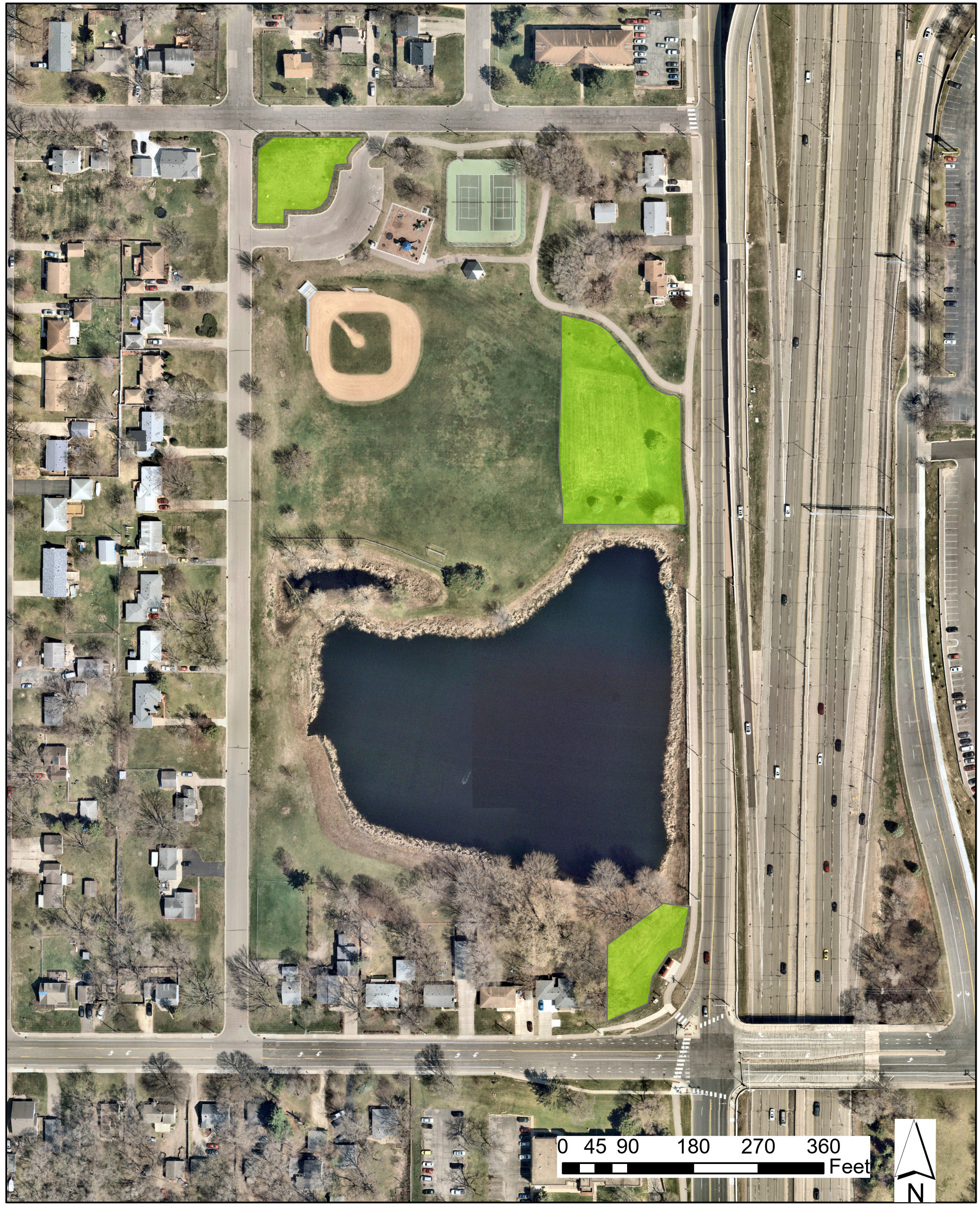
Completed Project Archive
The city is restoring 1.2 acres of Brookside Park, 10000 Xerxes Avenue South, into native prairie and savanna habitat. The area being restored has previously been managed as one of Bloomington’s reduced frequency mowing areas; being mowed only 3-4 times per year.
This process will further increase sustainability of the site by reducing mowing even more while also providing more aesthetic value, pollinator habitat, wildlife habitat, and improved water quality around the pond.
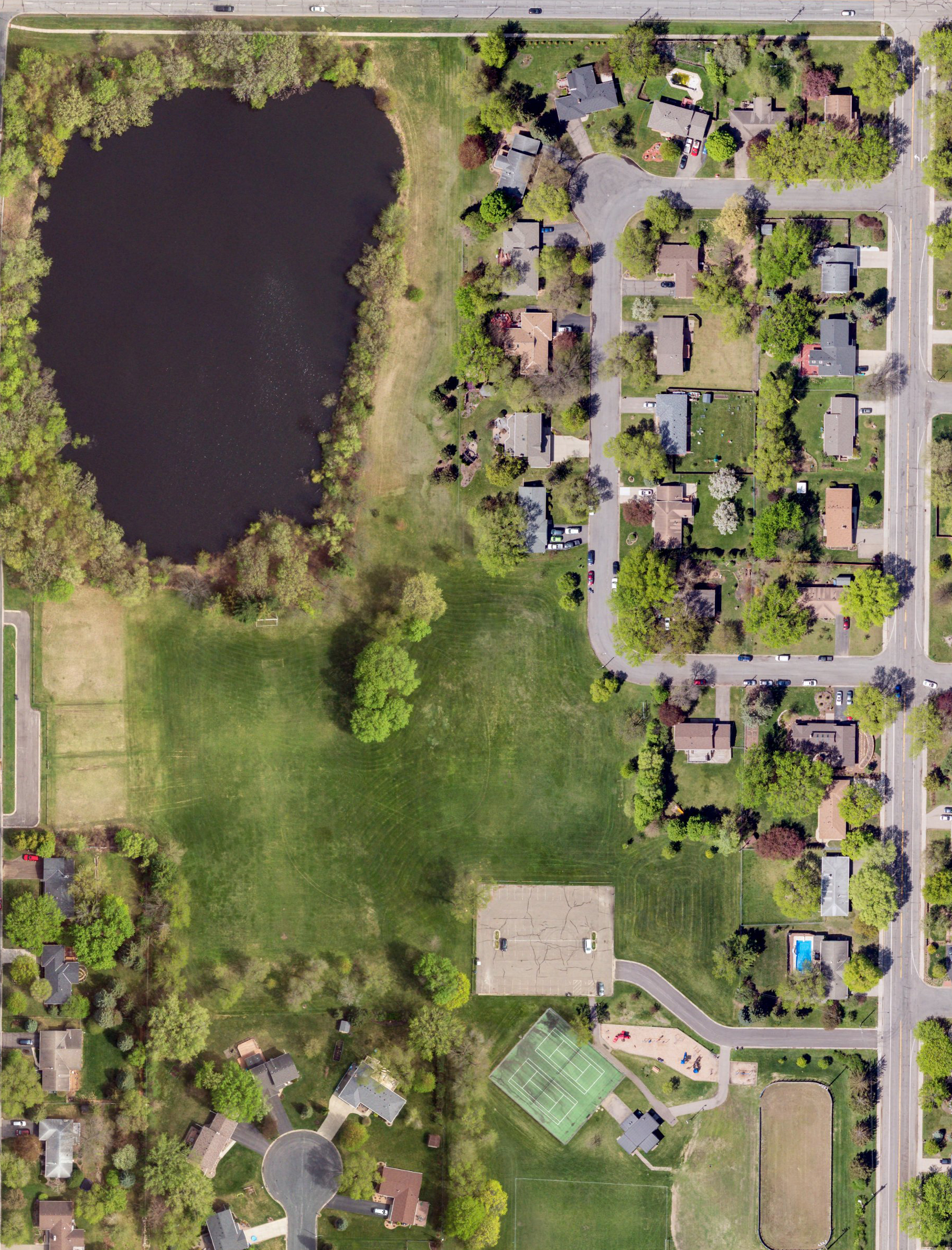
UPDATE JUNE 28, 2022
Brookside Park was seeded on June 28, 2022. The site was planted using a no-till drill to minimize soil disturbance and erosion. A Short Upland Dry seed mix was used throughout the site. This diverse mix contained 36 different native grasses and forbs.
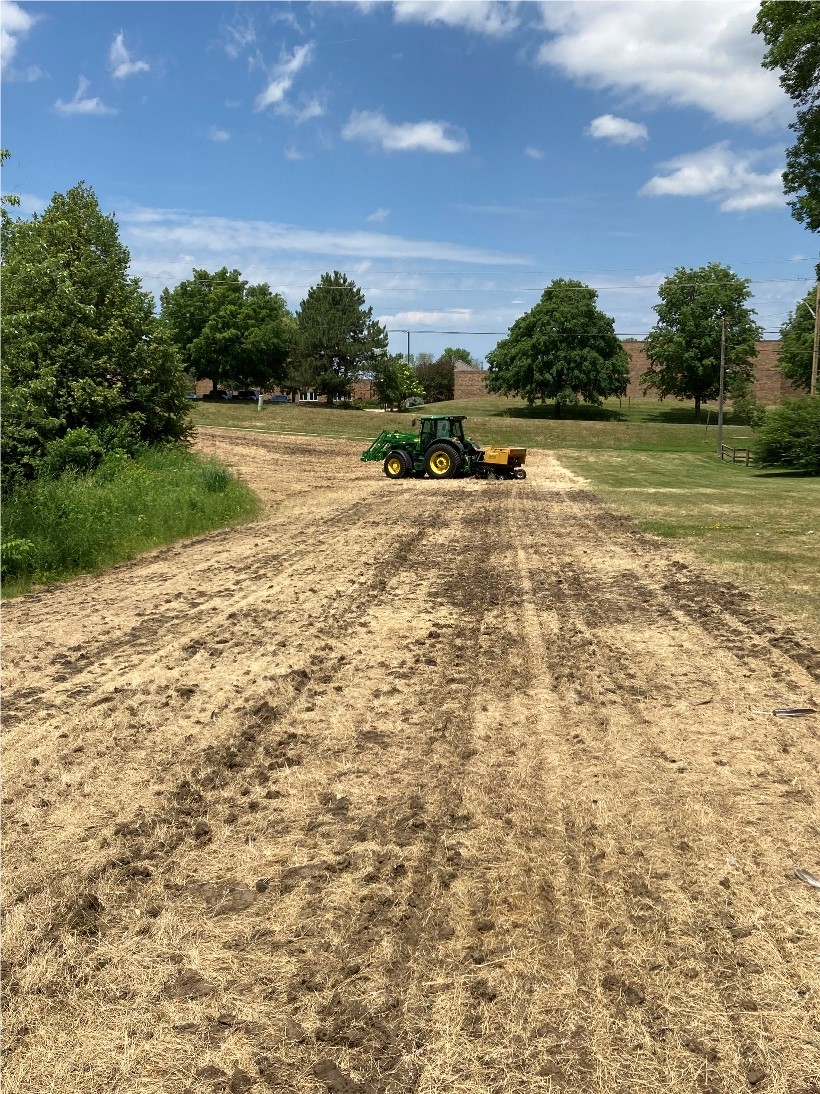
In November 2022, two acres of Haeg Park, 8301 Penn Ave. S., began conversion of turf into native oak savanna. The areas being restored were previously managed as reduced frequency mowing--mowed three to four times annually.
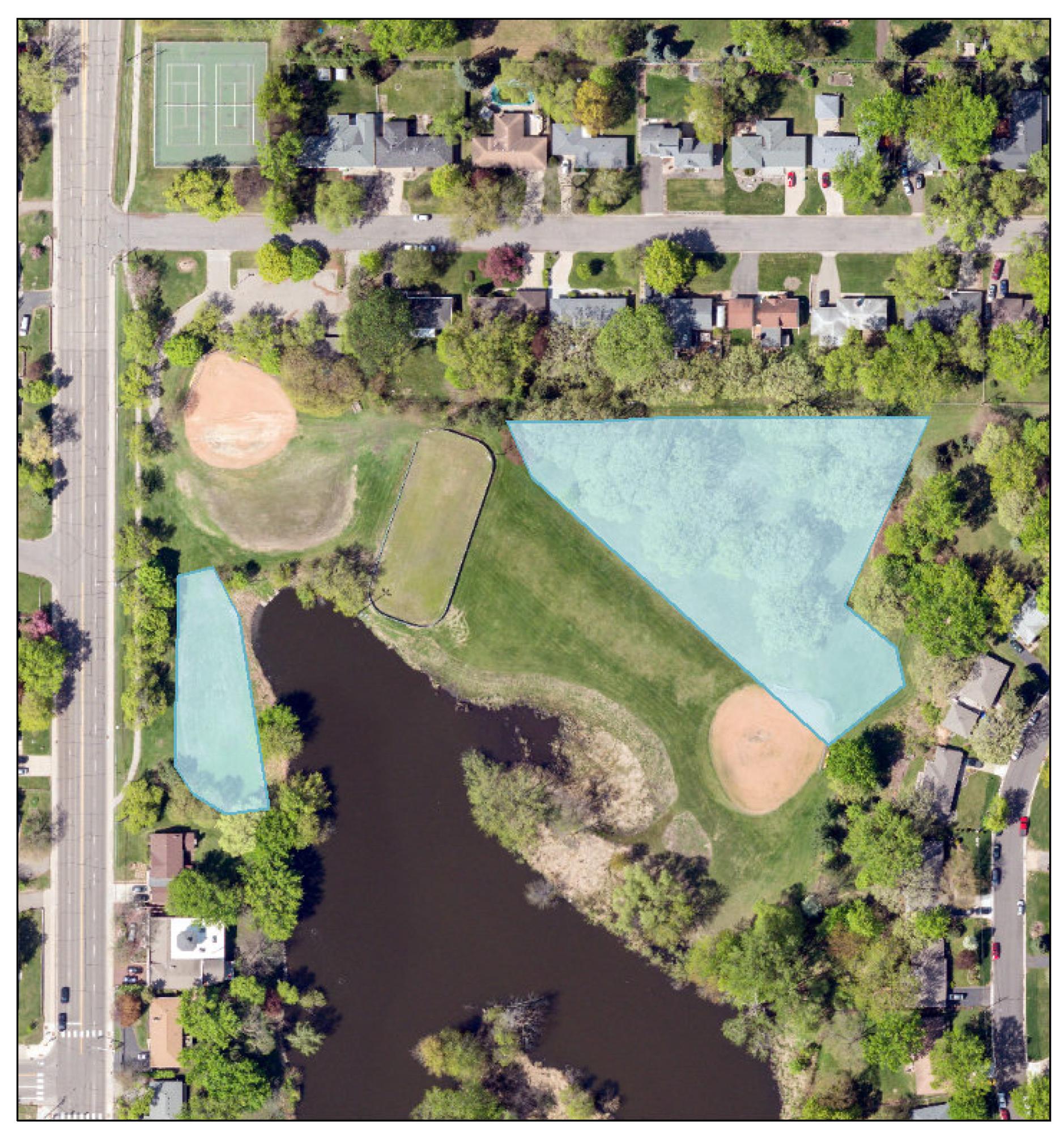
In June of 2022, the City began conversion of 3.5 acres of Running Park, 9501 12th Avenue South, into native prairie and savanna habitat. The area being restored was previously managed as one of Bloomington’s reduced frequency mowing areas; being mowed only 3-4 times per year.
This process will further increase sustainability of the site by reducing mowing even more while also providing more aesthetic value, pollinator habitat, wildlife habitat, and improved water infiltration around the pond.
UPDATE JUNE 29, 2022
Running Park was seeded on June 29, 2022. The site was planted using a no-till drill to minimize soil disturbance and erosion. A Short Upland Dry seed mix was used in areas that receive full sun throughout the day. A Shortgrass Savanna seed mix was used in areas under tree canopy or that are shaded for part of the day. The seed used contained a diverse mix of 36 native grasses and forbs.
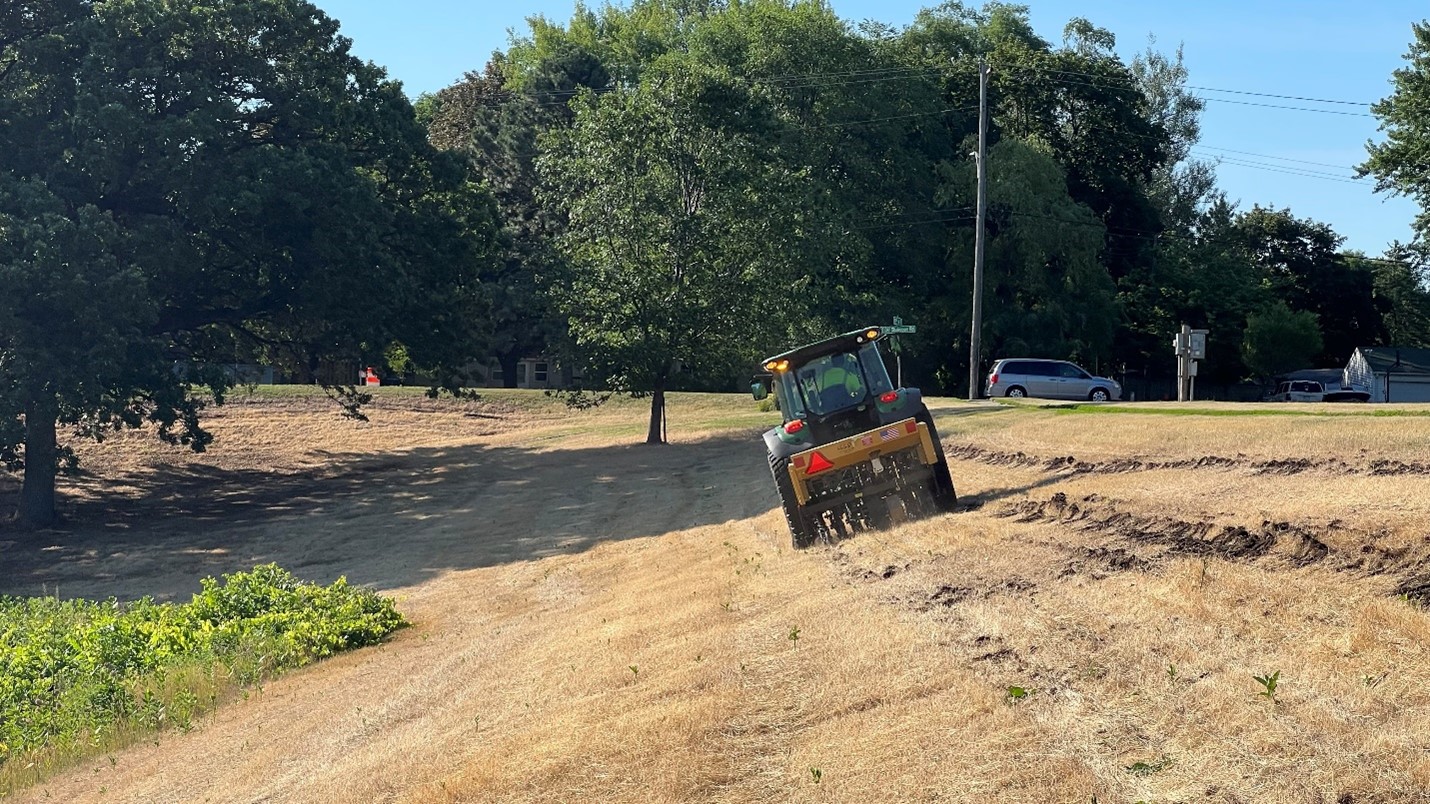
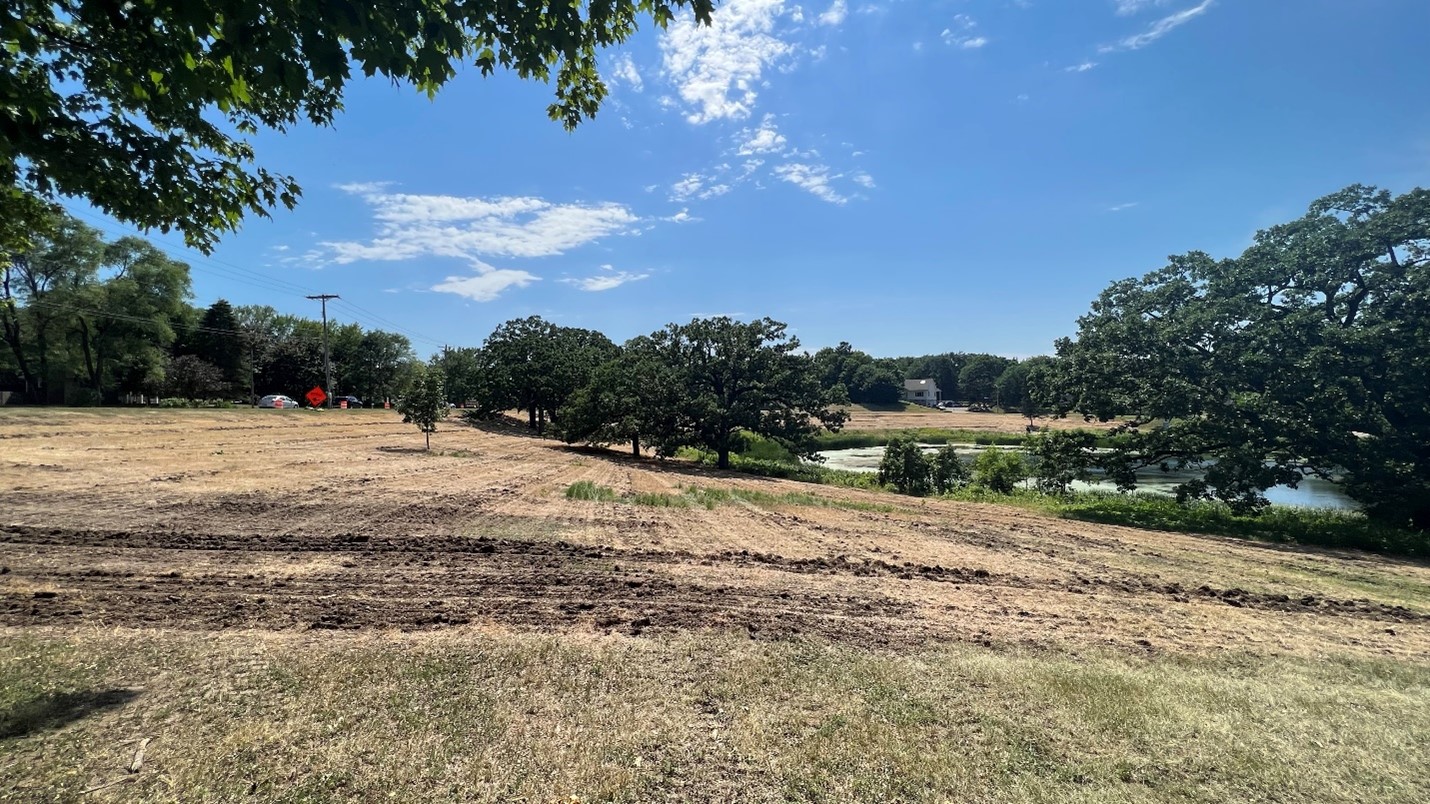
Volunteer Projects
The City of Bloomington Natural Resources staff partners with a variety of volunteer groups and organizations on restoration and natural area work throughout the City. Open the tabs below to get more information on some of these volunteer-led initiatives.
Marsh Lake Park Restoration Project
Restoration began by volunteers in 2020. The City of Bloomington has been involved from the start.
GOAL: Restore Marsh Lake Park into a healthy & naturally functioning ecosystem for all to enjoy.
Accomplishments (as of Fall 2024 – See Figure #1) :
- Drafted restoration plan for an Oak Openings and Barrens ridge and a Willow/Dogwood marsh.
- Removed invasive & over-populated vegetation.
- Cut material is piled for hauling or burning by City staff
- Planted native vegetation (grasses, flowers, etc.).
- Water new plants as needed.
- Active maintenance underway .
BNNN continues to provide volunteer assistance with maintenance activities following the restoration work.
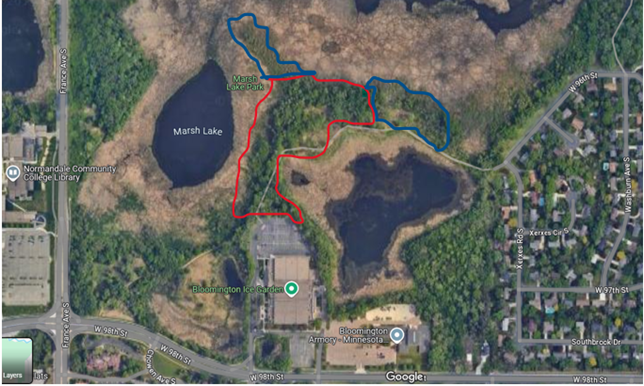
Forest Glen Park Invasives Removal & Native Vegetation Restoration
Buckthorn removal began by volunteers in 2022. City of Bloomington has been involved from the start and is part of the City of Bloomington Parks and Recreation Department's Adopt-A-Park program. Volunteer work is being coordinated with MN Valley National Wildlife Refuge Staff.
GOAL: Restore Forest Glen Park into a refuse free, healthy and naturally functioning ecosystem in support of the only trout stream (Ike’s Creek) in Hennepin County that begins as a natural spring in the park, within sight of the Mall of America (See Figure #2).
Establish vegetation along Ike’s Creek to protect the stream and keep water temperature in a range that supports the trout population.
Accomplishments (as of Fall 2024 – See Figure #3):
- Volunteers have been removing buckthorn and other invasive vegetation in Phase 1 area.
- Cut material has been piled for burning by City staff.
Proposed Ongoing: (through Bloomington's Natural Resources Participation Program - See Figure #3):
- Plant and/or seed native grasses and forbs in Phase 1 area that will thrive on a south facing slope.
- Remove invasive plants in Phase 2 and 3 areas, and plant/seed natives good for the north slope area.
- Provide volunteer assistance with maintenance activities following restoration work.
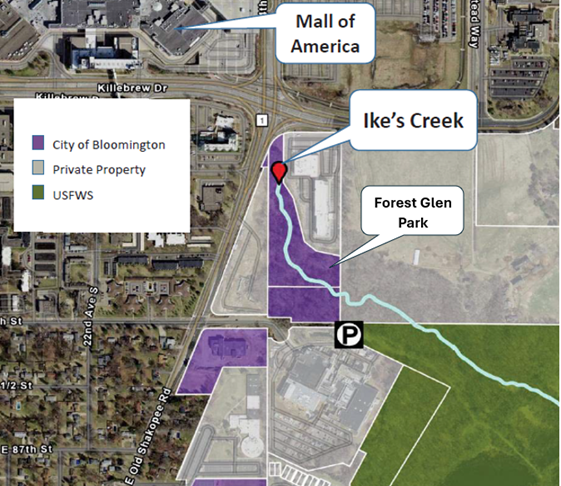
Figure #2. Forest Glen Park headwaters of Ike’s Creek, located across the street from The Mall of America. The Park consists of 3 parcels totaling 7.63 acres (5.15 + 2.42 + 0.06) abutting mostly private land.
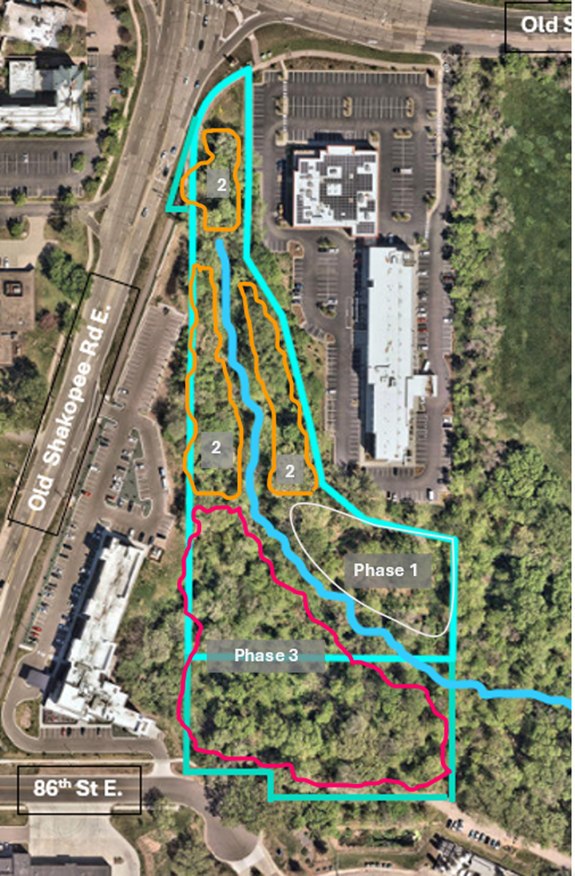
Figure #3. Detailed map of a 3-phase effort to restore a natural biome to Forest Glen Park.
Nine Mile Creek Restoration Project
Volunteers have begun work by clearing brush from the wet meadow near 106th and Humboldt as well as clearing dead down wood in areas of oak growth. This work is an enhancement to a Hennepin County funded restoration project that covered a combined 13 acres of Woodland, Oak Savanna, Mesic Prairie habitat. The work gathering and piling down wood will allow the area to be mowed periodically. The ability to use mowing equipment is key to successful future managing of the restoration.
- GOAL: To work alongside the City to enhance and contribute to the success of natural area restoration efforts in and around the 9-Mile Creek Corridor.
- Accomplishments (as of Fall 2024) :
- Clearing brush and gathering down wood near 106th and Humboldt in the Nine Mile Creek Corridor.
Ongoing:
- Intention to recruit volunteer neighbors of the park to manage invasive plants in their lots to prevent them from returning. We are open to working with other groups to connect these neighbors with resources that will eliminate invasive plants with the tried-and-true method of replacing them with native plantings.
- Opportunities for participation in volunteer projects associated with the Local Option Sales Tax funded restoration project in the Nine Mile Creek Corridor.
- Providing volunteer assistance with maintenance activities following restoration work.
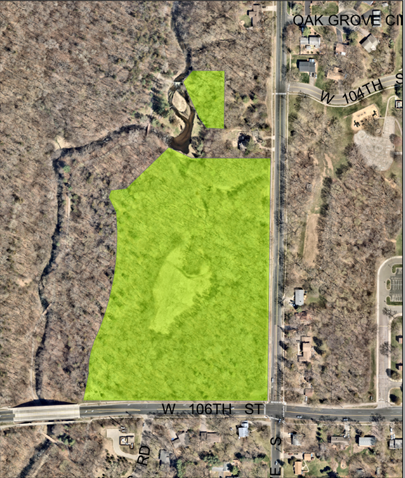
Natural Resources Restoration Process
Restorations bring back the native flora that once covered much of the city. It is a diverse mix of native grasses and forbs that increase biodiversity, wildlife and pollinator habitat, water infiltration, and sustainability. These native landscapes include wetlands, woodlands, savanna, and prairie that have been lost due to development. The primary focus of restoration initiatives is on prairie and savanna habitats.
The City of Bloomington currently manages approximately 200 acres of restored prairie, with plans to increase this number in the near future. These restorations are important for the city because they:
- Increase sustainability by reducing maintenance costs and input
- Reduce erosion and runoff into our waterways through better water infiltration
- Provide optimal habitats for pollinators due to high diversity of native flowers
- Provide opportunities for residents to learn more about native plants
Step-by-Step Plan
City of Bloomington restoration projects follow a comprehensive five-step plan that includes site evaluation and preparation, seeding and establishment, and ongoing maintenance. Click to expand the topics below to learn about each step in the process.
Objective: To assess current and past site conditions in order to make a decision on how to proceed with restoration.
- Current and past land usage.
- Soil type.
- Topography.
- Current vegetation.
Objective: Preparing the seed bed to reduce competition from non-desirable plant species for optimal native seed germination. (2-4 weeks)
- Remove undesirable vegetation from the site.
- Herbicide use may be necessary.
- Allow weeds to regrow, then remove to further deplete seed bank.
- Disturb the soil as little as possible to prevent erosion.
Objective: Get the native seed into the soil. (1-2 days)
- Utilize a no-till native seed drill to plant seed at optimal depth in soil and minimize erosion.
- Plant cover crop to further reduce erosion.
- Broadcast forbs on top of soil if necessary.
Objective: Maintain site in optimal condition for germination of seed and establishment of plants. (1-3 seasons post-seeding)
- Mow site one to three times the following season after seeding to allow sunlight to hit the seedlings and reduce annual/biennial weeds.
- Remove any perennial noxious weed species that appear using IPM.
- After the first season, mow as needed to further reduce weed competition.
- Monitor for successful growth of native species; reseed areas as needed.
Objective: Maintain the biodiversity and success of the newly established restoration. (After establishment)
- Dormant mow during spring or fall to reduce weed species and woody plants.
- Prescribed burns where allowed.
- Continue monitoring for noxious weed species and remove using IPM
- Inter-seed or plant plugs for more biodiversity.
Best Practices
Learn more about the best practices used by Bloomington Park Maintenance staff as they actively monitor and maintain natural areas within the City’s park system.
Department: Parks and Recreation
Division: Park Maintenance
Purpose: Bloomington Park Maintenance staff actively monitors and maintains natural areas within the city’s park system. These non-turf areas consist primarily of:
- Prairies
- Wetlands
- Rain gardens
- Shoreline buffers.
The primary reasons for managing natural areas are to provide wildlife habitat, economic and environmental benefits through reduced maintenance requirements, erosion control, and aesthetic value.
Best Management Practices: The City of Bloomington believes that it is in the best interest of the residents and the city to assume the responsibilities of maintaining natural areas. The City will provide such service in a cost-effective manner keeping in mind safety, budget, personnel, and environmental concerns. The City will use city employees, equipment, and private contractors to provide this service. Maintaining these areas requires consideration of biological processes, human impacts and multiple uses of the landscape. Since these impacts and uses change, maintenance also requires changing or refining methods. Methods are chosen depending on the plant community, weather, time of year, and the invasive plant in need of control. The Park Supervisor or designee is responsible for the scheduling of personnel and equipment.
Why does the City mow down flowers blooming in new seedings?
Mowing is part of the establishment process of prairie restoration. Mowing during the first three growing seasons is an accepted practice for the establishment period of native plantings. Although these flowers are aesthetically pleasing and part of the native seed mix planted on the site, they can become weedy and be detrimental to the overall health of the prairie.
- Mowing these dense stands of flowers increases the amount of light that reaches the ground and allows for other native seedlings to establish.
- Annual weeds grow in these areas and are best managed by mowing.
- Although it seems counterintuitive, the overall health of the prairie will increase, and biodiversity of the planting will improve as each season progresses.
- More flowers and grasses will fill in over the next few years, allowing more blooms for the entire growing season.
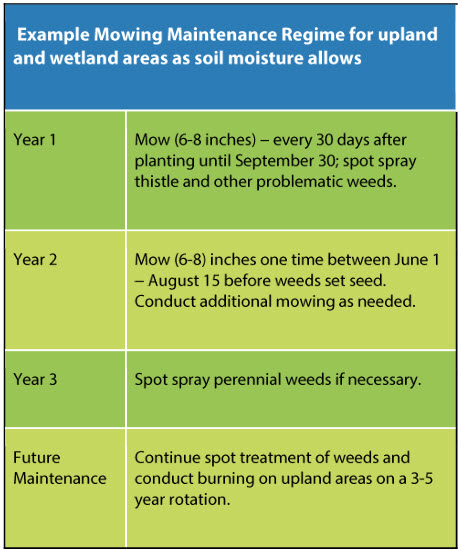
More information about establishment can be found on the Minnesota Board of Water & Soil Resources website, and in this useful guide from Prairie Moon Nursery.
Stories of Restoration







In addition to natural resources and restoration initiatives, the City is actively engaged in a wide variety of forestry work throughout Bloomington. Learn more on the Forestry page.
